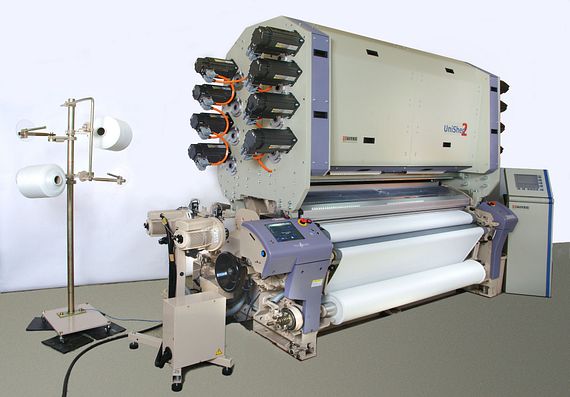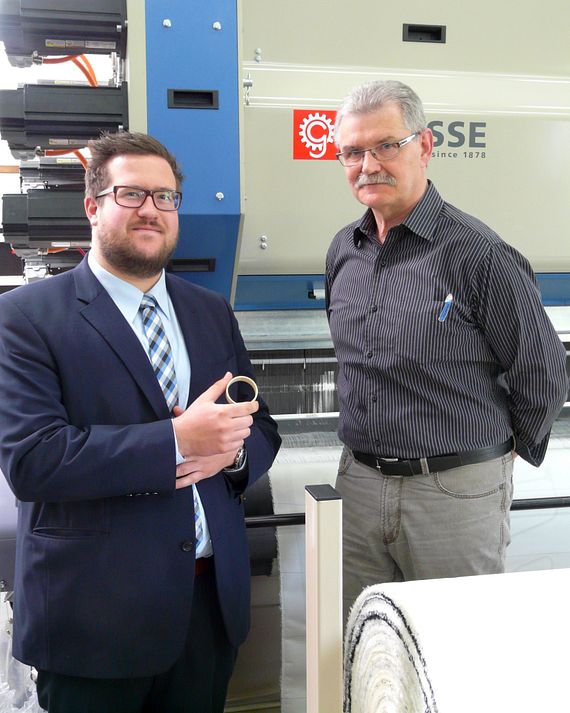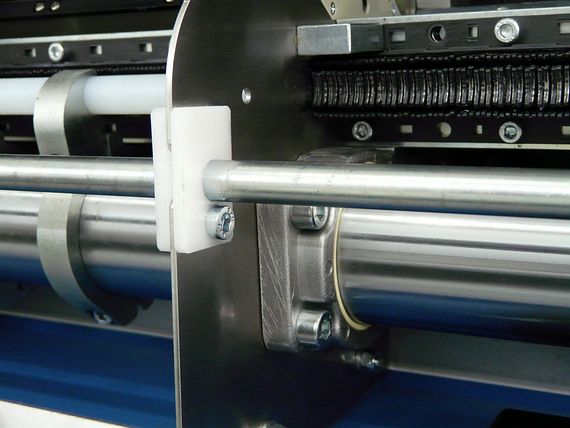Weaving without harness - Lubrication-free plastic bearings in innovative weaving machine
The UniShed 2 developed by Gitec GmbH is a completely new kind of weaving machine and therefore a real innovation. The reason is that the machines work without an electromechanical "harness" and, instead, use vibrating axes resting in bearings supplied by igus. For this purpose, bearing bushings made of the high-performance polymer iglidur J3 are used.
The textile industry is closely associated with the name Jacquard. In Lyon in 1800, Joseph-Marie Jacquard invented the loom named after him which scans the individual weaving pattern by means of punched cards. He made an important contribution to factory automation and also to the development of computer technology. Almost one hundred years later, pioneers such as Herman Hollerith used punched cards as data carriers for the first automated data-acquisition machines.
The textile industry is closely associated with the name Jacquard. In Lyon in 1800, Joseph-Marie Jacquard invented the loom named after him which scans the individual weaving pattern by means of punched cards. He made an important contribution to factory automation and also to the development of computer technology. Almost one hundred years later, pioneers such as Herman Hollerith used punched cards as data carriers for the first automated data-acquisition machines.

Problem
Permanent movements in 24/7 operation. The machines should have as long a service life as possible, because every downtime is associated with a lot of repair and maintenance work and costs.Solution
With the material iglidur J3 a significant improvement of the service life could be achieved. The freedom from maintenance and lubrication ensures that no dust or dirt from the environment is bound to the bearing points.Roland Michel, Head of Development at Gitec GmbH.
The world's first Jacquard machine without a harness
The punched-card system of the looms were not superseded by electronic control units until the 1980's. The underlying mechanical principle has survived or continues to survive even longer. The individual warp threads are moved through the so-called "harness system", a mechanical connection that uses hooks and pulley blocks or return springs to lift or lower each heddle in accordance with the desired pattern. The individual harnesses are usually operated with the help of magnets.Nowadays, there is a considerably more flexible alternative to this very complicated method. It is the UniShed 2, developed by Gitec GmbH as the world's first Jacquard weaving machine without a harness. In this machine, each warp thread is individually controlled by means of a Piezo actuator. A mechanical oscillation system replaces the traditional harness system that uses hooks and return springs.

Big advantages of the new weaving method
This innovation has numerous advantages. Head of development, Roland Michel: "The machines enable absolute freedom when it comes to patterning because the process can be controlled more effectively and efficiently. They work extremely reliably because each individual thread is monitored optically. Moreover, the machines are very compact and consume around 20 per cent less energy. “A first prototype of the UniShed 2 has already been tried out by a user in a field test while others are being tested on the premises of Gitec. In the textile industry, the development is attracting a lot of attention and Gitec is expecting it to achieve lasting success on the market: "We are convinced that the new method will supersede 80 per cent of the old technology."
Sought after: highly durable and lubrication-free bearings
The technical design challenges that had to be met when the first prototype machine was being built included the bearings for the oscillating shafts, which have a diameter of 50 millimetres and are moved by servomotors by means of an electronic cardan shaft drive. Roland Michel: "These bearings are subjected to a large amount of stress as the shafts oscillate and the machines work as endurance runners in 24/7 mode. At the same time, they have to manage without any external lubrication because the woven fabric is produced underneath the shafts. At first, we used another manufacturer's bearings, which worked without problems but were very expensive. We made the switch to igus bearings because the textile industry is very sensitive to prices and several bearings are needed for each individual axis."Newly developed polymer material in use
Originally, the standard iglidur J material was envisaged. It is real endurance runner material, is very wear-resistant and has a low degree of moisture absorption. But in accordance with the saying "Better is the enemy of good", igus developed iglidur J3 as a new material that is characterised by its even better resistance to wear. Depending on the conditions of use, a service life up to three times longer than that of iglidur J is achieved.
In addition, the degree of moisture absorption of this material, which has been included in the standard range of products together with 15 other high-performance polymers since the beginning of the year, is lower. This characteristic is also very important for Gitec, as Roland Michel explains: "Our machines are often in use in countries where humidity is very high. There, the plastics can swell when put in storage even before they are used, a factor that affects the bearing clearance. “
New methods of airbag manufacture
The machine, which is currently being used in the Technikum training centre in Neu-Ulm, is equipped with eleven modules each with 128 piezo actuators. As each module is supported by two bearings, there are 22 iglidur J3 bushings with a diameter of 50 millimetres on each axis.With the UniShed 2 machines, Gitec is aiming at the classical applications of Jacquard weaving machines such as clothing, home textiles and – very specially – technical fabrics made of polyester and polyamide as well as GRP/CRP materials. At the moment, new methods of airbag production are being tested in Neu-Ulm. Roland Michel: "Up to now, the airbags consisted of two parts sewn together, whereby each part was first cut to shape and coated. With the UniShed 2, we are now trying out a method of weaving whereby hollow bags consisting of one piece of material are produced. This makes the process considerably easier."
As the subsidiary of a Chinese corporation, which concentrates on the process chain of textile production, Gitec GmbH, a company that arose from Grosse, the traditional textile machine manufacturer, also has direct access to the practice of industrial weaving. The parent company operates its own weaving mills near Shanghai which manufacture high-quality Jacquard fabric for technical applications.
